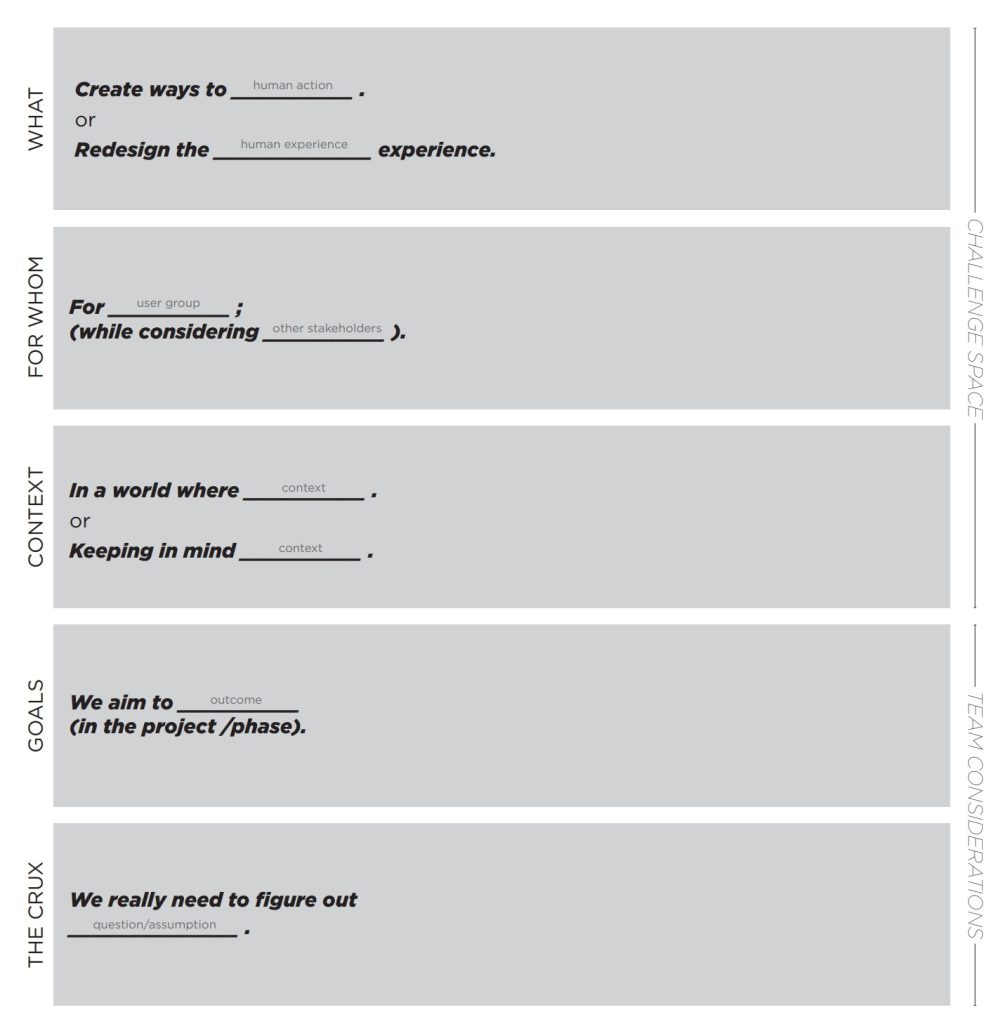4 Define
Hasso Plattner Institute of Design at Stanford and Frances Davis
Define (and Refine)
The art of defining the scope of a project requires you to create an actionable direction but also leave room for discovery and exploration. In the most open innovation work, you don’t know what solution or even what type of solution (event, campaign, service, product, digital platform . . .) will be most effective. In this class you know that your end solution must be a product. But the goal of defining your project is not to eliminate ambiguity. Ambiguity is necessary to allow for new discovery. How you frame a challenge will affect how much ambiguity exists, and target areas where exploration will happen.
Five Elements to Define (or Frame) a Design
The first three elements describe the challenge space to be explored. The last two elements describe the design team’s considerations: what are we trying to get done, and where do we need to check ourselves?
WHAT
What’s the challenge space? What human experience are you trying to affect?
What
Create ways to ____________ .
or
Redesign the ____________ experience.
Both of these are intended to frame efforts in terms of what you are doing for people (not the thing you are creating).
FOR WHOM
For what group of people are you designing? Our tendency is to want to broaden this as much as possible (“Runners” or “Teachers”); it can be much more fruitful to narrow your focus with a specific user group. Even if you want to affect a broad group, scope your work by choosing a place to start (“New members of the Hillsdale location gym” or “Math teachers at Lincoln Elementary”).
For whom
For ______(user group)_________ ;
Who are you designing for?
CONTEXT
What are the important facts that are known, or insights already gained that set context and explain the challenge at hand and why it matters?
Context
In a world where __________ .
or
Keeping in mind __________ .
Use the findings from your secondary sources to support your stance. Often facts of the situation paint a good contextual picture. For example, “This group orders take-out on average 3 times a week.” instead of “People hate cooking.”
GOALS
What are the explicit goals of the design team. This can be straight forward: “Build a prototype of an app to help runners in the Hillsdale gym complete running challenges with local members.”
Goals
We aim to __________ (in the project).
What is the overall goal of your project. In your semester project, what will your build?
CRUX
When it comes down to it, what are you trying to figure out? Why are you employing an exploratory process? What’s not already known?
Crux
We really need to figure out _______________ .
What is it that you will explore in the design process? For your design project often you will want to correct a flaw you found in other designs.
DO IT YOURSELF:
Use the five elements discussed to define (frame) your project. Play and adjust each blank and notice how the definition of the project changes. Tweak the scaffolding sentences (the phrases given below) if needed.


